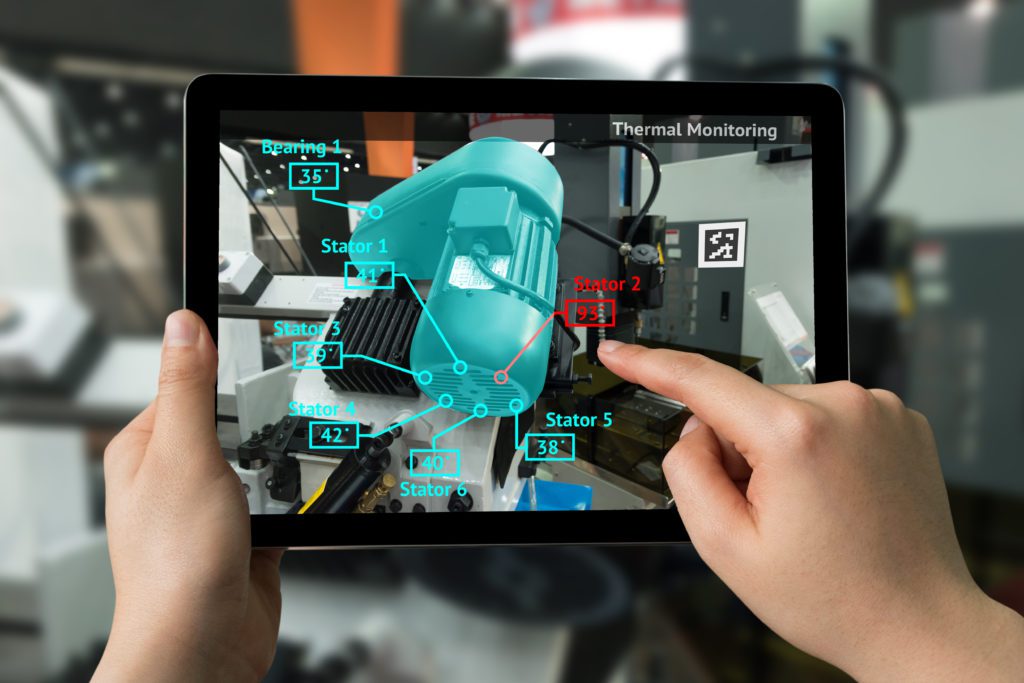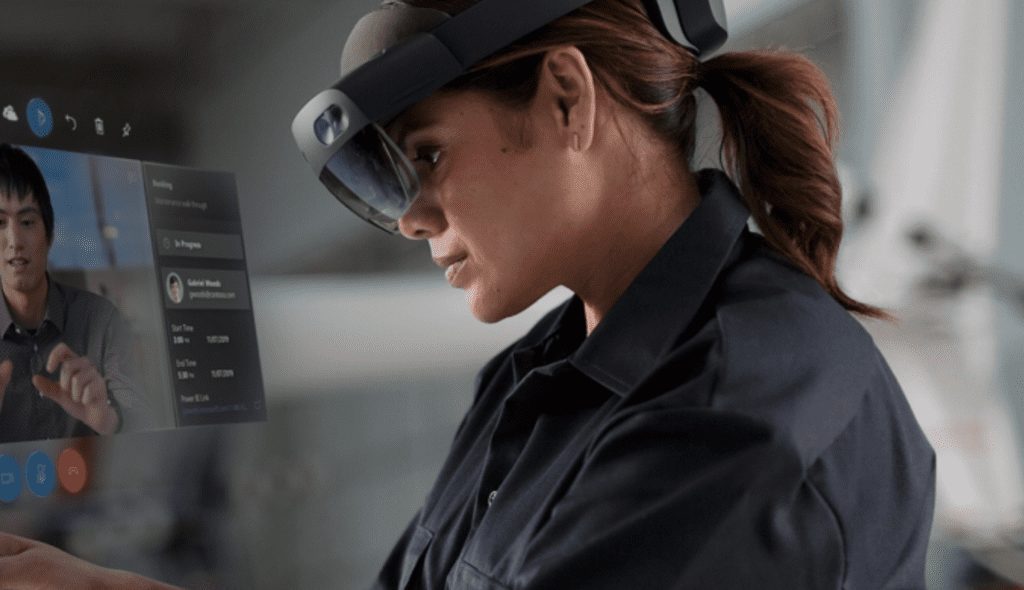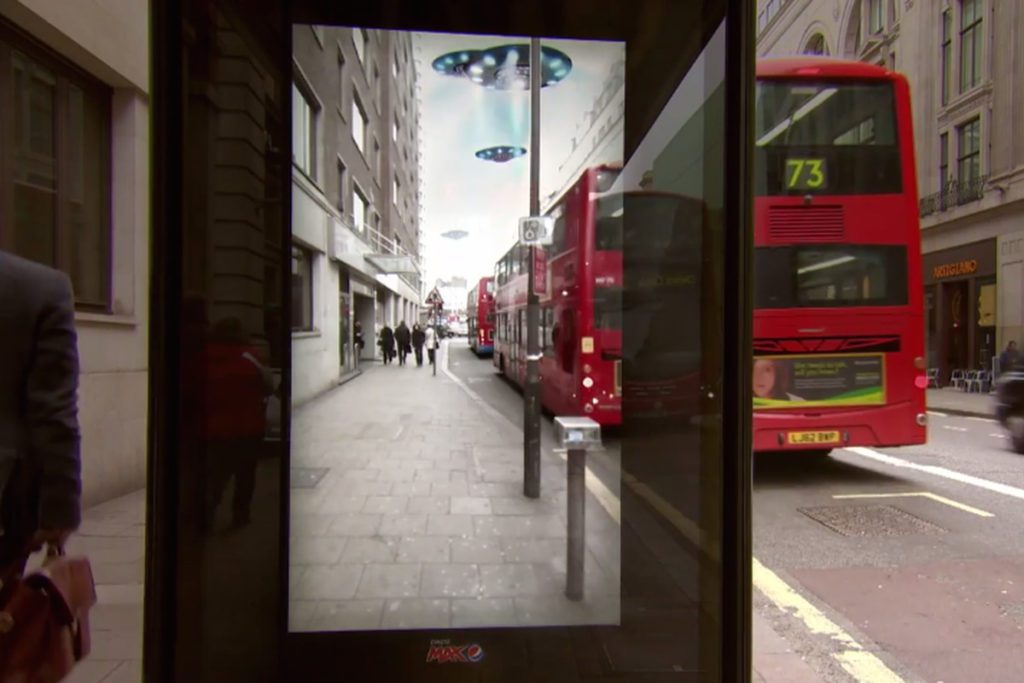Great organisations are always looking at new ways to improve operational performance to run more effectively and efficiently. Introducing new technologies is often a brilliant way to make positive changes – and augmented reality has the potential to not just change the way we view the world, but how we work too.
But how can augmented reality help to revolutionise the world of work? Here are four ways that AR can be integrated into core operational activity to make a tangible difference.
1. Using AR to Gain new workplace skills

Augmented reality can help organisations to train existing staff, as well as helping with onboarding of new recruits.
A programme of AR training can ensure a consistent approach to skills development that is more involved and visually engaging than classroom or online training. It offers practical experiences where learning can take place in the workplace, allowing the trainee to take a hands-on approach and practice tasks numerous times. This helps them to build muscle memory and perfect techniques, but doing so with tailored guidance in a risk-free environment.
This approach isn’t just more engaging for employees; it significantly helps to improve retention of knowledge. A recent study by Neuro-Insight found the part of the brain responsible for memory encoding saw almost three times the level of activity when engaging with AR versus non-AR, making it a great way of getting employees up to speed when learning or honing skills.
This means that augmented reality is increasingly being recognised for its potential to deliver training in highly technical, precision-critical and complex roles. For some professions, such as surgery, it also addresses the paradox of the need for practical training where repetition is key, but where on-the-job training can be difficult, as the smallest of mistakes could have serious consequences.
2. Working safely with remote support

For technical jobs, especially those where workers are working either remotely or in isolation, AR can help to transform how problematic tasks are successfully completed.
Moreover, when technicians are armed with wearable tech such as the Microsoft Hololens 2 rather than a smartphone or tablet, it can mean they can work hands-free while they are able to see and hear key information, helping them to work more efficiently and effectively.
3. Design and modelling using Augmented Reality

Augmented reality isn’t just a great technology for hands-on, process-driven work; it’s also a fantastic tool for product design and development. It can, quite simply, make rapid prototyping even more rapid.
Augmented reality can do this by taking 3D modelling to the next level. By creating models that can overlay the real world that are accurate and detailed, as well as full sized and interactive, models take on a truly realistic look and feel. This gives product designers the chance to create design iterations that can be easily tested and thoroughly interrogated. Designs can also be shared with other teams, clients and beyond, to get additional feedback and input.
4. Connecting with customers

While being a gimmick is counter-productive when introducing AR technology into a business, standing out from competitors with something unique and eye-catching is one of the key strengths of augmented reality when it comes to experiential marketing activity.
A great example is the Pepsi Max bus stand experience, where commuters at a bus stop in London witnessed incredible content such as giant robots marching down the road through a display window that looked like clear glass initially. This was done by producing 2D and 3D assets that were compsited into a live feed of the street using depth mapping. And although this was an incredible experience for those witnessing it at first hand, its power reached way beyond those on the street, as a social video spread throughout the world, reaching over 3 million views in just five days, in addition to coverage in mainstream media.
For the retail sector, AR takes the guesswork out of the purchasing equation. It gives potential customers the chance to try before they buy – whether that’s online, in store, at a tradeshow – and beyond. Virtual changing rooms can give customers the chance to try digital versions of clothing on before the point of purchase. Beauty apps such as Modiface have the potential to revolutionise how we shop for cosmetics in the future, by offering users access to photo-realistic make up simulations. And for top end purchases, such as furniture and cars, AR can give customers the chance to envisage their customised products, such as car interiors or experience products such as furniture in situ at home, but do so prior to buying.
Is the future of business an augmented one?
While the focus of AR has often been in the kooky gamification of the world around us through the development of headline grabbing apps such as Pokemon Go, its potential goes way beyond the world of play. Over the coming years, as apps become more sophisticated, coupled with the ongoing development of hardware and the rollout of 5G, augmented reality has the potential to revolutionise how we see and experience the world around us.
For organisations across all industry sectors, there are tangible business benefits for introducing AR technology. Although an AR experience can be visually stunning, it needs to have purpose. Ensuring that AR technology is being introduced to address a specific strategic or operational challenge, and that there is a firm business case for choosing the technology is the key to success.
The Future Visual team are here to help you to integrate augmented reality technology into your business. So why not contact them today to find out more?
Great organisations are always looking at new ways to improve operational performance to run more effectively and efficiently. Introducing new technologies is often a brilliant way to make positive changes – and augmented reality has the potential to not just change the way we view the world, but how we work too.
But how can augmented reality help to revolutionise the world of work? Here are four ways that AR can be integrated into core operational activity to make a tangible difference.
1. Using AR to Gain new workplace skills

Augmented reality can help organisations to train existing staff, as well as helping with onboarding of new recruits.
A programme of AR training can ensure a consistent approach to skills development that is more involved and visually engaging than classroom or online training. It offers practical experiences where learning can take place in the workplace, allowing the trainee to take a hands-on approach and practice tasks numerous times. This helps them to build muscle memory and perfect techniques, but doing so with tailored guidance in a risk-free environment.
This approach isn’t just more engaging for employees; it significantly helps to improve retention of knowledge. A recent study by Neuro-Insight found the part of the brain responsible for memory encoding saw almost three times the level of activity when engaging with AR versus non-AR, making it a great way of getting employees up to speed when learning or honing skills.
This means that augmented reality is increasingly being recognised for its potential to deliver training in highly technical, precision-critical and complex roles. For some professions, such as surgery, it also addresses the paradox of the need for practical training where repetition is key, but where on-the-job training can be difficult, as the smallest of mistakes could have serious consequences.
2. Working safely with remote support

For technical jobs, especially those where workers are working either remotely or in isolation, AR can help to transform how problematic tasks are successfully completed.
Moreover, when technicians are armed with wearable tech such as the Microsoft Hololens 2 rather than a smartphone or tablet, it can mean they can work hands-free while they are able to see and hear key information, helping them to work more efficiently and effectively.
3. Design and modelling using Augmented Reality

Augmented reality isn’t just a great technology for hands-on, process-driven work; it’s also a fantastic tool for product design and development. It can, quite simply, make rapid prototyping even more rapid.
Augmented reality can do this by taking 3D modelling to the next level. By creating models that can overlay the real world that are accurate and detailed, as well as full sized and interactive, models take on a truly realistic look and feel. This gives product designers the chance to create design iterations that can be easily tested and thoroughly interrogated. Designs can also be shared with other teams, clients and beyond, to get additional feedback and input.
4. Connecting with customers

While being a gimmick is counter-productive when introducing AR technology into a business, standing out from competitors with something unique and eye-catching is one of the key strengths of augmented reality when it comes to experiential marketing activity.
A great example is the Pepsi Max bus stand experience, where commuters at a bus stop in London witnessed incredible content such as giant robots marching down the road through a display window that looked like clear glass initially. This was done by producing 2D and 3D assets that were compsited into a live feed of the street using depth mapping. And although this was an incredible experience for those witnessing it at first hand, its power reached way beyond those on the street, as a social video spread throughout the world, reaching over 3 million views in just five days, in addition to coverage in mainstream media.
For the retail sector, AR takes the guesswork out of the purchasing equation. It gives potential customers the chance to try before they buy – whether that’s online, in store, at a tradeshow – and beyond. Virtual changing rooms can give customers the chance to try digital versions of clothing on before the point of purchase. Beauty apps such as Modiface have the potential to revolutionise how we shop for cosmetics in the future, by offering users access to photo-realistic make up simulations. And for top end purchases, such as furniture and cars, AR can give customers the chance to envisage their customised products, such as car interiors or experience products such as furniture in situ at home, but do so prior to buying.
Is the future of business an augmented one?
While the focus of AR has often been in the kooky gamification of the world around us through the development of headline grabbing apps such as Pokemon Go, its potential goes way beyond the world of play. Over the coming years, as apps become more sophisticated, coupled with the ongoing development of hardware and the rollout of 5G, augmented reality has the potential to revolutionise how we see and experience the world around us.
For organisations across all industry sectors, there are tangible business benefits for introducing AR technology. Although an AR experience can be visually stunning, it needs to have purpose. Ensuring that AR technology is being introduced to address a specific strategic or operational challenge, and that there is a firm business case for choosing the technology is the key to success.
The Future Visual team are here to help you to integrate augmented reality technology into your business. So why not contact them today to find out more?































